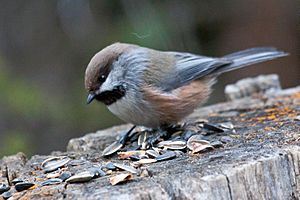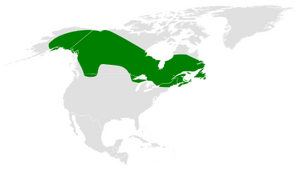Boreal chickadee facts for kids
Quick facts for kids Boreal chickadee |
|
|---|---|
 |
|
| Conservation status | |
| Scientific classification | |
| Genus: |
Poecile
|
| Species: |
hudsonicus
|
 |
|
| Range of Poecile hudsonicus | |
| Synonyms | |
|
Parus hudsonicus |
|
The boreal chickadee (Poecile hudsonicus) is a small passerine bird in the tit family Paridae. It is found in the boreal forests of Canada and the northern United States.
Contents
Description
Adults are 12.5–14.5 cm (4.9–5.7 in) long with a weight of 7–12.4 g (0.25–0.44 oz). They have grey-brown upperparts with a brown cap and greyish wings and tail; their face is mainly grey with white on the sides. Their underparts are white with brown on the flanks and a black throat. They have a short dark bill, short wings and a long notched tail.
| Standard Measurements | |
|---|---|
| length | 130–140 mm (5–5.5 in) |
| weight | 10 g (0.35 oz) |
| wingspan | 210 mm (8.25 in) |
| wing | 63.2–66.2 mm (2.49–2.61 in) |
| tail | 59–65.9 mm (2.32–2.59 in) |
| culmen | 7.6–9.8 mm (0.30–0.39 in) |
| tarsus | 16–17.5 mm (0.63–0.69 in) |
The call is a husky tsik-a-dee-dee, a variant on the call which gives chickadees their name.
Behavior
Their breeding habitat is coniferous woods in Canada, Alaska, and the northern edges of the northernmost portions of the lower forty-eight United States. They remain within their breeding range throughout the year, but sometimes move south in winter. Winter movements south of their range, however, appear to have become increasingly rare. They nest in a hole in a tree; the pair excavates the nest, using a natural cavity or sometimes an old woodpecker nest. Five to seven eggs are laid, white with fine reddish-brown spotting. The pair remains together year round and may mate for life.
These birds forage on conifer branches or probe into the bark, eating mainly insects and seeds, which may be stored for later use. They often forage in small flocks including other small birds, especially in winter.
Taxonomy
The species was formerly placed in the genus Parus with most other tits, but mtDNA cytochrome b sequence data and morphology suggest that separating Poecile more adequately expresses these birds' relationships. Molecular phylogenetic studies have shown that the boreal chickadee is sister to the chestnut-backed chickadee (Poecile rufescens).
- Poecile hudsonicus in Field Guide: Birds of the World on Flickr
- species name is missing
See also
 In Spanish: Carbonero boreal para niños
In Spanish: Carbonero boreal para niños


